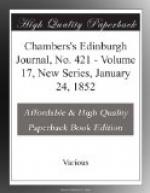He lifts the window-sash; and instantly there run out on the sill two or three minute lizards of a new kind, allied to the gecko, the common palette-tip (Sphoeriodactylus argus.) It is scarcely more than two inches long, more nimble than fleet in its movement, and not very attractive.
In the woods he would meet with other kinds. On the trunks of the trees he might frequently see the Venus (Dactyloa Edwardsii), as it is provincially called; a lizard much like the anoles of the houses, of a rich grass-green colour, with orange throat-disk, but much larger and fiercer; or, in the eastern parts of the island, the great iguana (Cyclura lophoma), with it dorsal crest like the teeth of a saw running down all its back, might be seen lying out on the branches of the trees, or playing bo-peep from a hole in the trunk; or, in the swamps and morasses of Westmoreland, the yellow galliwasp (Celestus occiduus), so much dreaded and abhorred, yet without reason, might be observed sitting idly in the mouth of its burrow, or feeding on the wild fruits and marshy plants that constitute its food.—Gosse’s Naturalist’s Sojourn.
A SCENE IN NEW ENGLAND.
I leave Boston sometimes in the evening by rail, get thirty miles off, then strike away into byways, ramble for an hour or two, and get back to the rail. I was out yesterday, and nothing can equal the colour of the foliage: if it was painted, it would look like fancy. In the course of my stroll, I came upon a lake entirely surrounded with forest, and containing, as I was informed, about four square miles of water, studded with islands varying in size from one to twenty acres. I would describe a point of view which enchanted me. I was on one side of the lake, where it is about half a mile in width: about half-way across, for the foreground of my picture, is a small island, about two acres, covered with trees, looking as if they grew out of the lake, with a central one of at least eighty feet high, and of the purest orange colour. The opposite shore is of a crescent shape, with the forest rising like an amphitheatre behind, glowing with every imaginable colour, from the intense crimson to the pale pink, and looking exactly like an enormous flower-garden stretching away to the distance, and the colour so strongly reflected




